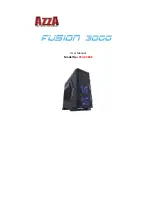
20
Maintaining the Appearance of Stainless Steel
It is a common misconception that stainless steel is stain and rust proof, making surface maintenance
not required at all. This is simply not true. Like mill galvanized steel, stainless steel is most effective
when kept clean. This is especially true when located in atmospheres with chloride salts, sulfides or
other rusting metals. In these environments, stainless steel can discolor, rust or corrode.
Once the unit arrives at the job site, the most effective way of maintaining the stainless steel
finish is to keep it clean! Always protect the stainless steel components from contamination
with steel or other rusting materials. The most common ways of contamination are due to
grinding and welding in the vicinity of the stainless steel tower or steel particles collected in the
piping connecting the tower to the cooling system. At a minimum, the unit should be washed
down annually to reduce residual dirt or surface deposits on the stainless steel. In addition, this
wash down will keep the stainless steel components free from the corrosive elements in the
atmosphere including chlorides and sulfides which are damaging to stainless steel.
Cleaning of Stainless Steel
Routine Maintenance – Mild Cleaning
Simple pressure washing (of sheet metal components only), using household cleaners,
detergents or ammonia annually (more frequently in marine or industrial environments) will
help maintain the finish and keep it free of atmospheric contaminants.
Minor Surface Dirt – Mildly Aggressive Cleaning
Use of a sponge or bristle brush with a non-abrasive cleaner is recommended. After
cleaning, rinse with warm water from a hose or pressure washer. Towel dry cleaned area
and coat area with a high quality wax to provide extra protection.
More Aggressive Cleaning – Removal of Fingerprints or Grease
Repeat processes 1 and 2, then use a hydro-carbon solvent like Acetone or alcohol. As
with any hydro-carbon solvent, caution must be taken when using the product. Do not use
in confined spaces or while smoking. Keep solvents out of contact with hands and skin.
Household glass cleaner, Spic n’ Span are other options for cleaners. After cleaning, towel
dry and apply a coat of high quality wax for extra protection.
Aggressive Cleaning – Removing Stains or Light Rust
If iron contamination or surface staining is suspected, immediately remove the stain or rust using
a chrome, brass or silver cleaner. The use of mild non-scratching creams and polishes are also
recommended. When the cleaning procedure is complete; use a high quality wax for extra protection.
Most Aggressive Cleaning – Removing Heavy Rust Deposits, Iron Contamination,
Spot Weld Discoloration and Weld Spatter using Acid
First try processes 1 through 4. If the stain or rust is not removed, the following should be
used as a last resort. Rinse the surface with hot water. Use a saturated solution of oxalic
or phosphoric acid (10 to 15% acid solution). This should be applied with a soft cloth and
allowed to stand for a few minutes – do not rub. This acid should etch out the iron particles.
Follow this with an ammonia and water rinse. Rinse the surface again with hot water; coat
with a high quality wax for added protection. Use extreme caution when working with acids!
Synthetic rubber gloves should be used, goggles and aprons are advisable.
DO NOT USE THIS METHOD IF THE UNIT HAS GALVANIZED STEEL COMPONENTS.
As a minimum, these guidelines should be followed to maintain and clean the stainless steel unit.
When cleaning stainless steel, NEVER use coarse abrasives or steel wool, NEVER clean with
mineral acids and NEVER leave stainless in contact with iron or carbon steel.
For more information on cleaning stainless steel, please request a copy of EVAPCO’S Engineering
Bulletin 40.
Summary of Contents for AT 110-112
Page 39: ...39 ...
















































